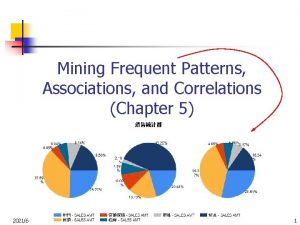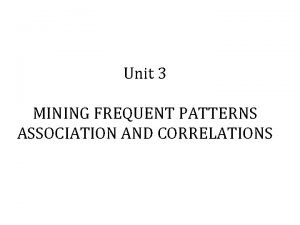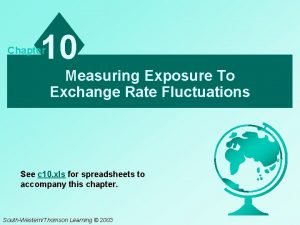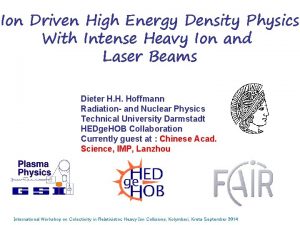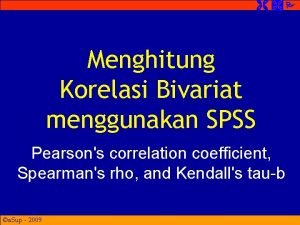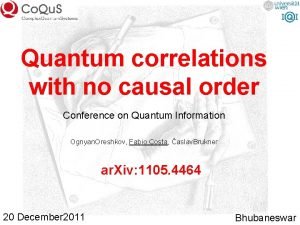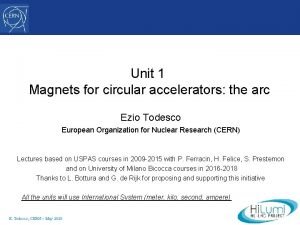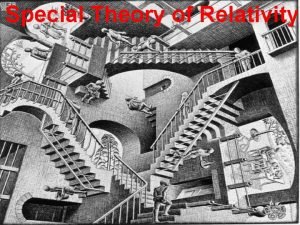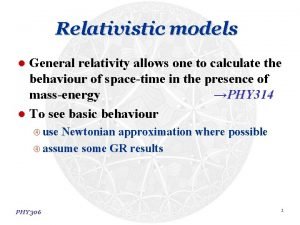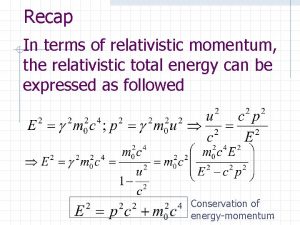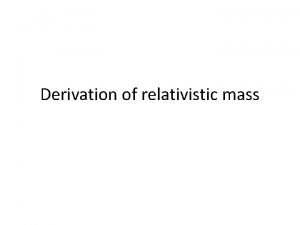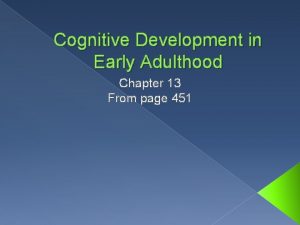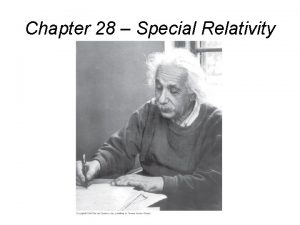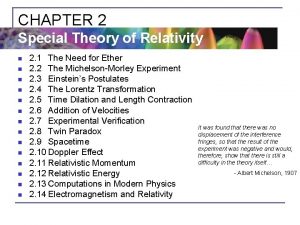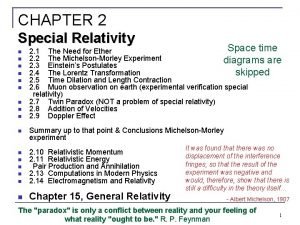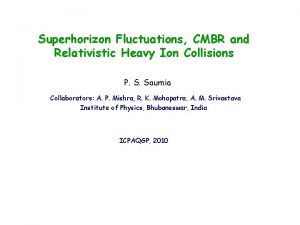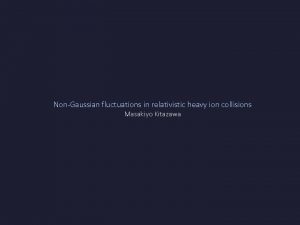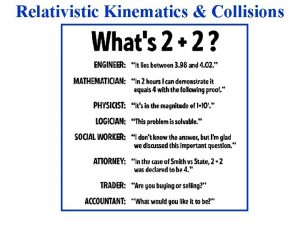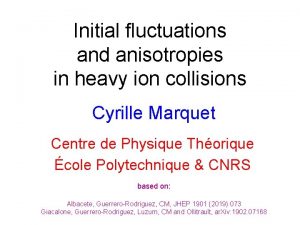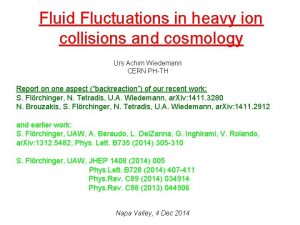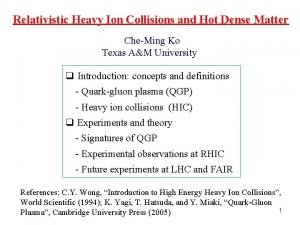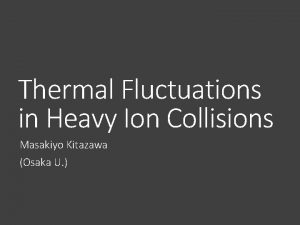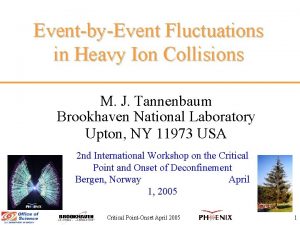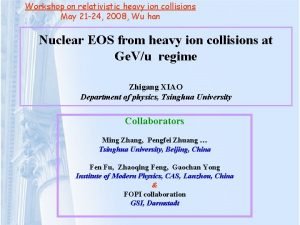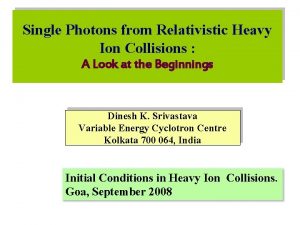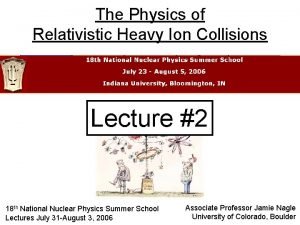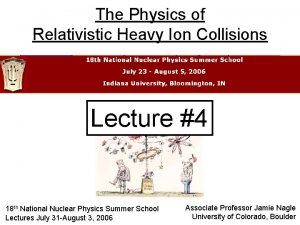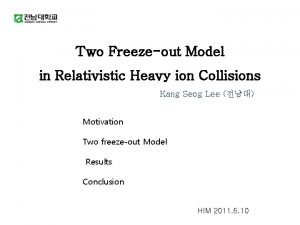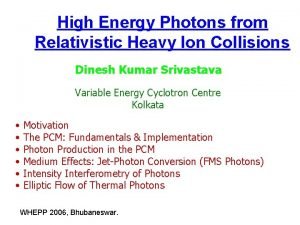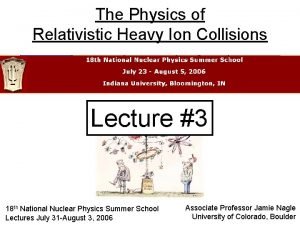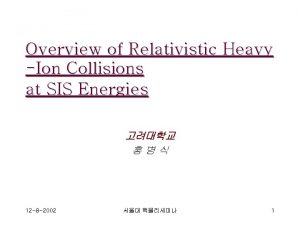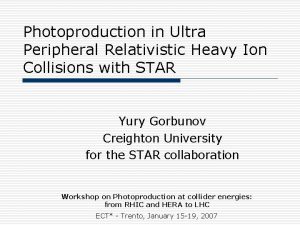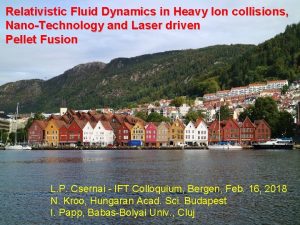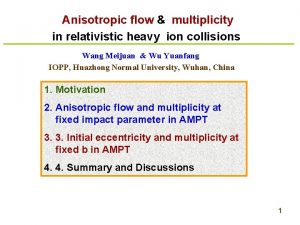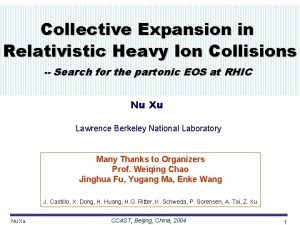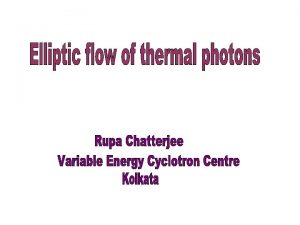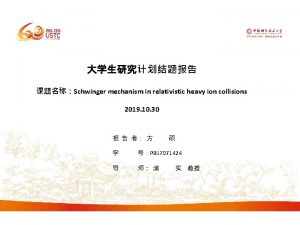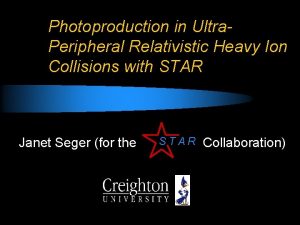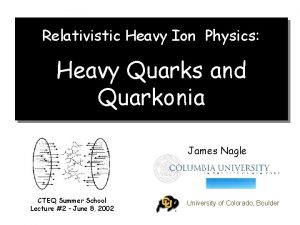Fluctuations and Correlations in Relativistic Heavy Ion Collisions






























- Slides: 30

Fluctuations and Correlations in Relativistic Heavy Ion Collisions Jeffery T. Mitchell (Brookhaven National Laboratory) Outline: - Charge Fluctuations - Balance Functions - Event-by-event <p. T> Fluctuations - Looking Ahead - Conclusions, Credits, Apologies 1

Charge Fluctuations Hypothesis: Fluctuations in net charge and net baryon number may be significantly reduced if a QGP is formed in the collisions Asakawa, Heinz, Müller PRL 85(2000)2072; Jeon & Koch PRL 85(2000)2076 Fractional electric charges of the quarks ==> Charges more evenly spread in a plasma ==> Reduced net charge fluctuations in a small region of phase-space Hadron Gas Scenario Quark-Gluon Plasma Scenario Jeffery T. Mitchell (BNL) – QM 2004 2

Summary of Charge Fluctuation Measures Quoted in this presentation Jeffery T. Mitchell (BNL) – QM 2004 3

Charge Fluctuation Magnitude Expectations Fq v(Q) D n+-, dyn (STAR) (PHENIX) (NA 49) Independent Particle Emission 1. 0 4. 0 0. 0 Resonance Gas 0. 75 3. 0 -0. 0013 -0. 006 -0. 125 Quark-Gluon Plasma 0. 25 1. 0 -0. 0038 -0. 019 -0. 375 Quark Coalescence 0. 83 3. 33 -0. 0008 -0. 004 -0. 084 Jeffery T. Mitchell (BNL) – QM 2004 4

Charge Fluctuations vs. Rapidity Acceptance (Excitation Function): NA 49 Ch arg e. C on ser vat ion Qu ark Co ale sce nce Ga s Re son a Qu ark Pla -Glu sm on a See poster by P. Chrisakogiou Jeffery T. Mitchell (BNL) – QM 2004 Correction for fluctuations due to charge conservation. Also see talk by H. Sako for new CERES results. 5

Charge Fluctuations vs. Rapidity Acceptance Phys. Rev. Lett. 89 (2002) 082301, 130 Ge. V. = /2, 0. 3 p. T 2. 0 Ge. V/c Quark Coalescence Charge Conservatio n Resonance Gas Quark-Gluon Plasma Jeffery T. Mitchell (BNL) – QM 2004 6

Charge Fluctuations vs. Rapidity Acceptance Phys. Rev. C 68 (2003) 044905, 130 Ge. V. Charge Quark Co alescenc e Resonanc e Conserv ation Gas Quark. Gluon Plasma Jeffery T. Mitchell (BNL) – QM 2004 7

Balance Functions Bass, Danielewicz, & Pratt, Phys. Rev. Lett. 85, 2689 (2000) N+ - (Dy) = Histogram of | y(p+) - y(p--) |, for all possible pairs within an event. This histogram is summed over all events. • Designed to determine whether hadronization from a QGP occurs early (<1 fm/c) or late. Early hadronization scenario: Pairs separate in rapidity due to expansion and rescattering. • Based upon the fact that charge is conserved locally, and produced pairs are initially correlated in coordinate space. • Bottom line: The balance function is narrower in the delayed hadronization scenario. Delayed hadronization scenario: Pairs are more strongly correlated in rapidity. Jeffery T. Mitchell (BNL) – QM 2004 8

STAR 130 Ge. V Balance Function Results Phys. Rev. Lett. 90 (2003) 172301. All Charged Hadron Pairs Jeffery T. Mitchell (BNL) – QM 2004 Identified Pion Pairs 9

STAR 200 Ge. V Balance Function Widths The balance function gets narrower in central collisions Delayed hadronization scenario? See talk tomorrow by G. Westfall Increasing Centrality Jeffery T. Mitchell (BNL) – QM 2004 10

NA 49 17 Ge. V Balance Function Widths Preliminary See talk by M. Gazdzicki The balance function gets narrower in central collisions. A similar behavior AND narrowing magnitude is observed compared to the STAR data! Increasing Centrality Jeffery T. Mitchell (BNL) – QM 2004 11

Other explanations for the broadening of the balance function Resonance contributions P. Bozek, W. Broniowski, and W. Florkowski, -th/0310062 nucl Computing balance functions in a thermal model with neutral resonance decay. The calculations including resonances are consistent with the STAR results. Quark Coalescence Model Predictions A. Bialas, hep-ph/0308245. 0 -10% a width consistent 10 -40% B. Predicts centrality with the STAR result for central collisions with a transverse flow velocity below 0. 5 c. 40 -70% centrality Jeffery T. Mitchell (BNL) – QM 2004 70 -96% centrality 12

<p. T> Fluctuations: Probing for Signs of a Phase Transition Analogy: Critical Opalescence Movie of a sealed container containing freon on a hot plate at the critical point. The image is projected onto a wall. Movie by the University of Minnesota Physics Department M. Stephanov et al. , Phys. Rev. Lett. 81 (1998) 4816: Suggest that near a tricritical end-point in the QCD phase diagram, event-byevent fluctuations in average p. T could increase significantly. B. Berdnikov and K. Rajagopal, Phys. Rev. D 61 (2000) 105017: Estimate that the effect could be a 10 -20% increase in average p. T fluctuations. Jeffery T. Mitchell (BNL) – QM 2004 13

Behold The Signal! Jeffery T. Mitchell (BNL) – QM 2004 14

Summary of Event-by-event <p. T> Fluctuation Measures Goal of the observables: State a comparison to the expectation of statistically independent particle emission. Fp. T s 2 p. T, dyn Dsp. T, n Quoted in this presentation Fp. T Jeffery T. Mitchell (BNL) – QM 2004 Sp. T 15

How To Measure A Fluctuation Gamma distribution calculation for statistically independent particle emission with input parameters taken from the inclusive spectra. See M. Tannenbaum, Phys. Lett. B 498 (2001) 29. Red: Random Expectation (G distribution) Blue: STAR acceptance fluctuation of: fp. T=52. 6 Me. V, Fp. T=14%, s 2 p. T, dyn=52. 3 (Me. V/c 2), Sp. T=9. 8% Mp. T = Event-by-Event Average p. T Jeffery T. Mitchell (BNL) – QM 2004 16

A Positive Signal is Observed! Known contributions to the <p. T> fluctuation signal should be subtracted. Contributions from Known Processes n HBT – too small (NA 49, STAR, CERES) n Resonances – too small (NA 49, STAR) n Elliptic Flow – too small/negligible (PHENIX, CERES, NA 49) n Hard Processes… n Or onset of thermalization… A Schematic Illustration of Elliptic Flow Jeffery T. Mitchell (BNL) – QM 2004 17

A Possible Explanation of the Signal: A System in Near-local Thermal Equilibrium Sean Gavin, nucl-th/0308067, see his talk tomorrow for more details. Jeffery T. Mitchell (BNL) – QM 2004 18

The onset of thermalization? See talks tomorrow by S. Gavin (model) and G. Westfall (data) Jeffery T. Mitchell (BNL) – QM 2004 19

A Large Fluctuation Contribution at high p. T 0. 2 < p. Tmax 0. 1 < p. Tmax Preliminary See talk by M. Tannenbaum 20 -30% centrality 20 -25% centrality This trend is observed at all centralities. See talk by H. Sako An increase in observed fluctuations grows primarily in a p. T region where number fluctuations vary little. Increases from p. Tmax=1. 0 to 2. 0 Ge. V/c PHENIX Fluctuations: 243% CERES Fluctuations: 34% <N>: < 15% Jeffery T. Mitchell (BNL) – QM 2004 20

Fluctuations: A Jet Contribution? A Schematic Illustration of Jet Suppression Jets inherently add particles that are correlated in p. T to the event, so a contribution due to hard processes is expected, but how much? What about jet suppression? Jeffery T. Mitchell (BNL) – QM 2004 21

Jet Simulation Results: PHENIX at 200 Ge. V Results from a 2 -component hybrid simulation. Component 1: Reproduce soft processes by sampling the inclusive p. T and N data distributions. Component 2: Embed PYTHIA hard scattering events at a given rate per particle produced in Part 1. Keep the rate fixed, or scale it by RAA. PHENIX Data: nucl-ex/0310005 This decrease is due to the signal competing with the Mp. T width increase for low N. This decrease is due to jet suppression? See poster by J. T. Mitchell 20 -25% centrality Jeffery T. Mitchell (BNL) – QM 2004 22

Jet Simulation Results: STAR at 130 Ge. V STAR data: nucl-ex/0308033 Error bars are the quoted total systematic error. The simulation predicts ~1520% increase when going from 130 to 200 Ge. V Jeffery T. Mitchell (BNL) – QM 2004 23

Jet Simulation Results: NA 49 at 17 Ge. V NA 49 Preliminary Data: See poster by Grebieszkow & M. Rybczynski Jeffery T. Mitchell (BNL) – QM 2004 K. 24

Estimate of the Magnitude of Residual Event -by-Event Temperature Fluctuations R. Korus and S. Mrowczynski, Phys. Rev. C 64 (2001) 054908. p inclusive p. T, G(p, b), p~1 s. T/<T>, Most central At the peak 1. 8% 3. 7% Measurement sqrt(s. NN) PHENIX 200 STAR 130 1. 7% 3. 8% CERES 17 1. 3% 2. 2% NA 49 17 0. 6% 1. 7% Jeffery T. Mitchell (BNL) – QM 2004 25

Add a dimension: 2 -point transverse momentum correlations Higher p NA 49 17 Ge. V Pb+Pb pairs from hard scattering ? t Data s(T) = 5 Me. V STAR Preliminary 130 Ge. V Au+Au ign s Like Thermal Fluctuation Model Simulations s(T) = 10 Me. V s(T) = 20 Me. V ary R STA min Preli hep-ex/0311009 L. Ray, DNP 2003, see his poster HBT and Coulomb interaction In PHENIX, x(1. 5 Ge. V/c) ~ 0. 93 Jeffery T. Mitchell (BNL) – QM 2004 26

Coming Soon: A Multi-dimensional Analysis (centrality, p. T, 1, p. T, 2, pseudorapidity, azimuth) T. Trainor, DNP 2003 STAR Preliminary See poster by D. Prindle Same side Opposite side Elliptic flow has been removed. Jeffery T. Mitchell (BNL) – QM 2004 27

Synopsis n Charge fluctuations: n n n Balance Functions: n n Both SPS (NA 49) and RHIC (STAR) results show a narrowing of the balance function in central collisions. The narrowing is indicative of delayed hadronization. The narrowing may also be explained within the quark coalescence picture, or by resonance decay contributions. <p. T> Fluctuations: n n SPS results and RHIC-PHENIX results are close to the random expectation after correcting for charge conservation. RHIC-STAR results are consistent with a quark coalescence model prediction in central collisions. A positive fluctuation signal that decreases for more central collisions is seen at the SPS and at RHIC. The signal can be explained within a model that simulates jet production, however, a jet suppression scenario must be introduced to describe the most central collisions at RHIC. The signal can also be explained within a thermalization onset scenario. Stay tuned for more exciting results soon! Jeffery T. Mitchell (BNL) – QM 2004 28

But wait! There’s more! The following topics could not be covered in this presentation. • Multiplicity Fluctuations • Spatial Fluctuations, or “Event Texture” • Charge/Neutral (Isospin) Fluctuations • Particle Ratio Fluctuations Acknowledgements Many thanks to H. Appelshauser (CERES), M. Gazdzicki (NA 49), S. Gavin, D. Prindle (STAR), L. Ray (STAR), C. Roland (NA 49), H. Sako (CERES), T. Trainor (STAR), G. Westfall (STAR), for providing input into this presentation. Jeffery T. Mitchell (BNL) – QM 2004 29

Auxiliary Slide Fluctuations According to HIJING 20 -25% centrality HIJING cannot reproduce the centrality dependence of the fluctuations. One problem is that <N> changes depending on the HIJING settings – not matched to the observed dataset. Example for 0 -5% centrality: <N> = 93. 0 for jet suppression, 76. 6 without suppression, and 51. 2 without jets. Jeffery T. Mitchell (BNL) – QM 2004 30
 Ratey rational functions
Ratey rational functions Mining frequent patterns associations and correlations
Mining frequent patterns associations and correlations X videos
X videos Mining frequent patterns associations and correlations
Mining frequent patterns associations and correlations Pulse frequency
Pulse frequency Measuring exposure to exchange rate fluctuations
Measuring exposure to exchange rate fluctuations Short-run fluctuations
Short-run fluctuations Measuring exposure to exchange rate fluctuations
Measuring exposure to exchange rate fluctuations Transaction exposure
Transaction exposure Heavy ion
Heavy ion Bivariat
Bivariat Quantum correlations with no causal order
Quantum correlations with no causal order Spurious correlations
Spurious correlations Illusory correlations ______.
Illusory correlations ______. Cognitive development early adulthood
Cognitive development early adulthood Ion dipolo
Ion dipolo Ion dipolo
Ion dipolo Fuerzas dipolo-dipolo ejemplos
Fuerzas dipolo-dipolo ejemplos Induced dipole induced dipole attraction
Induced dipole induced dipole attraction Relativistic circular motion
Relativistic circular motion Relativistic thinking example
Relativistic thinking example Relativistic mass
Relativistic mass Al's relativistic adventures
Al's relativistic adventures General relativity equation
General relativity equation Relativistic momentum
Relativistic momentum Relativistic thinking example
Relativistic thinking example Derivation of relativistic mass
Derivation of relativistic mass Cognitive changes in early adulthood
Cognitive changes in early adulthood Relativistic kinetic energy
Relativistic kinetic energy Relativistic velocity
Relativistic velocity Relativity
Relativity

